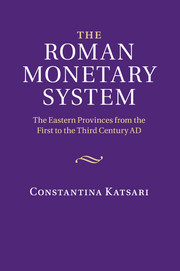Book contents
- Frontmatter
- Contents
- List of charts
- Acknowledgements
- List of abbreviations
- Framing the Roman Monetary System: An Introduction
- 1 Statistics and numismatics
- 2 Planning the financial policy of the Roman state
- 3 Trimetallism and bimetallic laws
- 4 The application of the Quantity Theory of Money to third-century economics
- 5 Roman monetary integration
- 6 Micro-economies
- 7 Metallism vs. chartalism
- Appendix 1 The inscription of Mylasa
- Appendix 2 Excavations finds, coin hoards and museums
- References
- Index
2 - Planning the financial policy of the Roman state
Published online by Cambridge University Press: 01 March 2011
- Frontmatter
- Contents
- List of charts
- Acknowledgements
- List of abbreviations
- Framing the Roman Monetary System: An Introduction
- 1 Statistics and numismatics
- 2 Planning the financial policy of the Roman state
- 3 Trimetallism and bimetallic laws
- 4 The application of the Quantity Theory of Money to third-century economics
- 5 Roman monetary integration
- 6 Micro-economies
- 7 Metallism vs. chartalism
- Appendix 1 The inscription of Mylasa
- Appendix 2 Excavations finds, coin hoards and museums
- References
- Index
Summary
The production of coinages in pre-industrial societies has been studied predominantly in conjunction with the financial plans of ancient and medieval states. In the Roman empire, specifically, the emperor – the embodiment of the Roman state – was considered responsible for both the financial imperial policy and the minting of precious-metal coinages during the Principate. It soon became obvious to modern historians that the regulation of the imperial budget depended on the extent of the state payments, especially the ones destined for the Roman troops. Since these payments took the form of minted coins, the direct control of the production of currency became essential. As early as the nineteenth century one of the most pre-eminent historians, Theodor Mommsen, closely linked the fiscal policy of the Roman emperors with the production of coins. He insisted that the minting of precious-metal coinages brought large profits to the Roman treasury, while subsequently he examined in more detail the expenditures of the state and especially the military expenses and soldiers' pay.
The prevalence of capitalism in the Western world and the communist economic model that was promoted after the Russian revolution seem to have altered substantially the views of modern historians with regard to the link between ancient fiscal policies and the production of coinage. Rostovtzeff certainly accepts that money was very important for the payment of salaries.
- Type
- Chapter
- Information
- The Roman Monetary SystemThe Eastern Provinces from the First to the Third Century AD, pp. 34 - 71Publisher: Cambridge University PressPrint publication year: 2011



